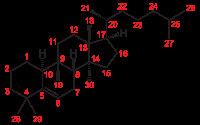 | ||
How to pronounce cucurbitacin
Cucurbitacin is any of a class of biochemical compounds that some plants — notably members of the family Cucurbitaceae, which includes the common pumpkins and gourds — produce and which function as a defence against herbivores. Cucurbitacins are chemically classified as steroids, formally derived from cucurbitane, a triterpene hydrocarbon — specifically, from the unsaturated variant cucurbita-5-ene, or 19-(10→9β)-abeo-10α-lanost-5-ene. They often occur as glycosides. They and their derivatives have been found in many plant families (including Brassicaceae, Cucurbitaceae, Scrophulariaceae, Begoniaceae, Elaeocarpaceae, Datiscaceae, Desfontainiaceae, Polemoniaceae, Primulaceae, Rubiaceae, Sterculiaceae, Rosaceae, and Thymelaeaceae), in some mushrooms (including Russula and Hebeloma) and even in some marine mollusks.
Contents
- How to pronounce cucurbitacin
- What does cucurbitacin mean
- Biosynthesis
- Variants
- Cucurbitacin A
- Cucurbitacin B
- Cucurbitacin C
- Cucurbitacin D
- Cucurbitacin E
- Cucurbitacin F
- Cucurbitacin G
- Cucurbitacin H
- Cucurbitacin I
- Cucurbitacin J
- Cucurbitacin K
- Cucurbitacin L
- Cucurbitacin O
- Cucurbitacin P
- Cucurbitacin Q
- Cucurbitacin R
- Cucurbitacin S
- Cucurbitacin T
- 2829 Norcucurbitacins
- Other
- Occurrence
- Bitter taste
- Deaths
- References
Cucurbitacins may be a taste deterrent in plants foraged by some animals and in some edible plants preferred by humans, like cucumbers. In laboratory research, cucurbitacins have cytotoxic properties and are under study for their potential biological activities.
What does cucurbitacin mean
Biosynthesis
The biosynthesis of Cucurbitacin C has been described recently. Zhang et al. (2014) identified nine cucumber genes in the pathway for biosynthesis of cucurbitacin C and elucidated four catalytic steps. These authors also discovered the transcription factors Bl (Bitter leaf) and Bt (Bitter fruit) that regulate this pathway in leaves and fruits, respectively. The Bi gene confers bitterness to the entire plant and is genetically associated with an operon-like gene cluster, similar to the gene cluster involved in thalianol biosynthesis in Arabidopsis. Fruit bitterness requires both Bi and the dominant Bt (Bitter fruit) gene. Nonbitterness of cultivated cucumber fruit is conferred by bt, an allele selected during domestication. Bi is a member of the oxidosqualene cyclase (OSC) gene family. Phylogenetic analysis showed that Bi is the ortholog of cucurbitadienol synthase gene CPQ in squash (Cucurbita pepo)
Variants
The cucurbitacins include:
Cucurbitacin A
25H
40O
2, white powder
Cucurbitacin B
25H
36O
4, white powder
Cucurbitacin C
Cucurbitacin D
Cucurbitacin E
Cucurbitacin F
Cucurbitacin G
Cucurbitacin H
Cucurbitacin I
Cucurbitacin J
Cucurbitacin K
Cucurbitacin L
Cucurbitacin O
Cucurbitacin P
Cucurbitacin Q
Cucurbitacin R
Cucurbitacin S
Cucurbitacin T
28/29 Norcucurbitacins
There are several substances that can be seen as derving from cucurbita-5-ene skeleton by loss of one of the methyl groups (28 or 29) attached to carbon 4; often with the adjacent ring (ring A) becoming aromatic.
Other
Several other cucurbitacins have been found in plants.
Occurrence
Constituents of the colocynth fruit and leaves (Citrullus colocynthis) include cucurbitacins.
The 2-O-β-D-glucopyranosides of cucurbitacins K and L can be extracted with ethanol from fruits of Cucurbita pepo cv dayangua.
Pentanorcucurbitacins A and B can be extracted with methanol from the stems of Momordica charantia.
Cucurbitacins B and I, and derivatives of cucurbitacins B, D and E, can be extracted with methanol from dried tubers of Hemsleya endecaphylla.
Bitter taste
Cucurbitacins impart a bitter taste in plant foods such as cucumber, melon and pumpkin.
Deaths
Pathologists found cucurbitacin in the stomach of a 79-year-old man who died in Bavaria, Germany, shortly after eating a casserole containing zucchini he had received from a neighbor. The "Chemische- und Veterinäruntersuchungsamt Stuttgart" (chemical and veterinary research authority) found cucurbitacin in a sample of the casserole the man had eaten shortly before his death. Maria Roth of that agency said that recent hot weather had likely stressed the plant, causing more toxin than usual to be present.
